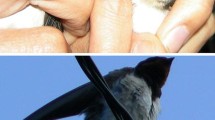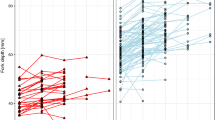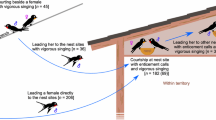Abstract
The evolution of secondary sexual characters is the subject of controversial debate between those defending their role as ‘viability indicators’ and those arguing that ornaments are purely ‘attractive traits’ selected by females. Recent theoretical studies suggest that these hypotheses are not mutually exclusive, as both viability and attractiveness can contribute to improve the reproductive success of progeny and could thus simultaneously underlie female choices. If that is the case, strategies of cheaper advertisement, allowing the expression of larger ornaments for the same cost, could proliferate even in species in which honest signalling of viability prevails. Under this scenario, different males could invest a different amount of resources per ornament unit of expression, thus using different signalling rules. We studied the relationship between tail feather length (a trait that is the subject of a female mate preference) and feather mass (a measure of investment in feather production) in a barn swallow Hirundo rustica population. Different males used different and consistent signalling rules when developing ornamental feathers. That is, to produce a feather of a given length, each male used a constant amount of resources across different years, but this amount varied between males. Although the amount of material invested in feathers (feather mass) is a condition-dependent trait, the organization of this material in ornamental feathers (i.e. the signalling rules) was not. Neither survival nor risk of feather breakage was related to the signalling rules. Thus, these results suggest that both ‘viability’ and ‘runaway’ mechanisms are independent determinants of the evolution of ornamental sexual feathers in the barn swallow. A preference for long tails will ensure that females either obtain a sire with high viability, or one transferring the capability to produce longer and more attractive tails at a lower cost of production to its offspring.




Similar content being viewed by others
References
Amundsen T (2000) Why are female birds ornamented? Trends Ecol Evol 15:149–155
Andersson M (1982) Sexual selection, natural selection and quality advertisement. Nature 299:818–820
Andersson M (1994) Sexual selection. Princeton University Press, Princeton
Aparicio JM, Bonal R, Cordero PJ (2003) Evolution of the structure of tail feathers: implications for the theory of sexual selection. Evolution 57:397–405
Backwell PRY, Christy JH, Telford SR, Jennions MD, Passmore NI (2000) Dishonest signalling in a fiddler crab. Proc R Soc Lond B 267:719–724
Barbosa A, Merino S, Cuervo JJ, de Lope F, Møller AP (2003) Feather damage of long tails in Barn Swallows Hirundo rustica. Ardea 91:85–90
Barnard P (1990) Male tail length, sexual display intensity and female sexual response in a parasitic African finch. Anim Behav 39:652–656
Bro-Jørgensen J, Johnstone RA, Evans MR (2007) Uninformative exaggeration of male sexual ornaments in barn swallows. Curr Biol 17:850–855
Buchanan KL, Evans MR (2000) The effect of tail streamer length on aerodynamic performance in the barn swallow. Behav Ecol 11:228–238
Candolin U (2000) Male-male competition ensures honest signalling of male parental ability in the three-spined stickleback (Gasterosteus aculeatus). Behav Ecol Sociobiol 49:57–61
Cotton S, Fowler K, Pomiankowski A (2004) Do sexual ornaments demonstrate heightened condition-dependent expression as predicted by the handicap hypothesis? Proc R Soc Lond B 271:771–783
Cotton S, Small J, Hashim R, Pomiankowski A (2010) Eyespan reflects reproductive quality in wild stalk-eyed flies. Evol Ecol 24:83–95
Cuervo JJ, Møller AP (2006) Experimental tail elongation in male Barn Swallows Hirundo rustica reduces provisioning of young, but only in second broods. Ibis 148:449–458
Dawkins MS, Guilford T (1991) The corruption of honest signalling. Anim Behav 41:865–873
Dufva R (1996) Blood parasites, health, reproductive success, and egg volume in female Great Tits Parus major. J Avian Biol 27:83–87
Fisher RA (1915) The evolution of sexual preferences. Eugenics Rev 7:775–787
Folstad I, Karter AJ (1992) Parasites, bright males, and the immunocompetence handicap. Am Nat 139:603–622
Griggio M, Devigili A, Hoy H, Pilastro A (2009) Female ornamentation and directional male mate preference in the rock sparrow. Behav Ecol 20:1072–1078
Hamilton WD, Zuk M (1982) Heritable true fitness and bright birds-a role for parasites. Science 218:384–387
Hoefler CD, Persons MH, Rypstra AL (2008) Evolutionarily costly courtship displays in a wolf spider: a test of viability indicator theory. Behav Ecol 19:974–979
Ihara Y, Aoki K, Feldman MW (2003) Runaway sexual selection with paternal transmission of the male trait and gene-culture determination of the female preference. J Theor Biol 63:53–62
Iwasa Y, Pomiankowski A (1994) The evolution of mate preferences for multiple sexual ornaments. Evolution 48:853–867
Jensen H, Steinsland I, Ringsby TH, Sæther BE (2008) Evolutionary dynamics of a sexual ornament in the house sparrow (Passer domesticus): the role of indirect selection within and between sexes. Evolution 62:1275–1293
Kleinbaum DG, Kupper LL, Muller KE (1988) Applied regression analysis and multivariable methods. Duxbury, Belmont, CA
Kokko H, Brooks R, McNamara JM, Houston AI (2002) The sexual selection continuum. Proc R Soc Lond B 269:1331–1340
Kotiaho JS (2001) Costs of sexual traits: a mismatch between theoretical considerations and empirical evidence. Biol Rev 76:365–376
Lande R (1981) Models of speciation by sexual selection on polygenic traits. Proc Natl Acad Sci USA 78:3721–3725
Møller AP (1988) Female choice selects for male sexual tail ornaments in monogamous swallow. Nature 332:640–642
Møller AP (1989) Viability costs of male tail ornaments in a swallow. Nature 339:132–135
Møller AP (1993) Sexual selection in the barn swallow Hirundo rustica 3. Female tail ornaments. Evolution 47:417–431
Møller AP (1994a) Sexual selection and the barn swallow. Oxford University Press, Oxford
Møller AP (1994b) Male ornament size as a reliable cue to enhanced viability in the barn swallow. Proc Natl Acad Sci USA 91:6929–6932
Møller AP (1996) Development of fluctuating asymmetry in tail feathers of the barn swallow Hirundo rustica. J Evol Biol 9:677–694
Møller AP, Alatalo RV (1999) Good-genes effects in sexual selection. Proc R Soc Lond B 266:85–91
Møller AP, de Lope F (1994) Differential costs of a secondary sexual character: an experimental test of the handicap principle. Evolution 48:1676–1683
Møller AP, Pomiankowski A (1993) Why have birds got multiple sexual ornaments. Behav Ecol Sociobiol 32:167–176
Møller AP, de Lope F, Saino N (1995) Sexual selection in the barn swallow Hirundo rustica 4. Aerodynamic adaptations. J Evol Biol 8:671–687
Møller AP, Barbosa A, Cuervo JJ, de Lope F, Merino S, Saino N (1998) Sexual selection and tail streamers in the barn swallow. Proc R Soc Lond B 265:409–414
Muñoz A, Aparicio JM, Bonal R (2008) Male barn swallows use different resource allocation rules to produce ornamental tail feathers. Behav Ecol 19:404–409
Murai M, Backwell PRY, Jennions MD (2009) The cost of reliable signalling: experimental evidence for predictable variation among males in a cost-benefit trade-off between sexually selected traits. Evolution 63:2363–2371
Murphy TG (2007) Racketed tail of the male and female turquoise-browed motmot: male but not female tail length correlates with pairing success, performance, and reproductive success. Behav Ecol Sociobiol 61:911–918
Palokangas P, Alatalo RV, Korpimäki E (1992) Female choice in the kestrel under different availability of mating options. Anim Behav 43:659–665
Pomiankowski A, Møller AP (1995) A resolution of the lek paradox. Proc R Soc Lond B 260:21–29
Prum RO (1999) Development and evolutionary origin of feathers. J Exp Zool 285:291–306
Pryke SR, Andersson S (2005) Experimental evidence for female choice and energetic costs of male tail elongation in red-collared widowbirds. Biol J Linn Soc 86:35–43
Radwan J (2002) Good genes go fisherian. Trends Ecol Evol 17:539
Rowe L, Houle D (1996) The lek paradox and the capture of genetic variance by condition dependent traits. Proc R Soc Lond B 263:1415–1421
Rowe LV, Buchanan KL, Evans MR (2001) The function and evolution of the tail streamer in hirundines. Behav Ecol 12:157–163
Saino N, Møller AP (1996) Sexual ornamentation and inmunocompetence in the barn swallow. Behav Ecol 7:227–232
Saino N, Bolzern AM, Møller AP (1997) Inmunocompetence, ornamentation and viability of male barn swallows (Hirundo rustica). Proc Natl Acad Sci USA 94:549–552
Saino N, Calza S, Ninni P, Møller AP (1999) Barn swallows trade survival against offspring condition and inmunocompetence. J Anim Ecol 68:999–1009
Simmons LV, Emlen DJ (2008) No fecundity cost o female secondary sexual trait expression in the horned beetle Onthophagus sagittarius. J Evol Biol 21:1227–1235
Smith HG, Montgomerie R (1991) Sexual selection and the tail ornaments of North American barn swallows. Behav Ecol Sociobiol 28:195–201
Tubaro PL, Mahler B, Lijtmaer DA (2005) Patterns of rectrix rachis modification in pintails and the evolution of sexually selected traits. Biol J Linn Soc 86:477–485
Veiga JP (1995) Honest signalling and the survival cost of badges in the house sparrow. Evolution 49:570–572
Vincent J (1990) Structural biomaterials. Princeton University Press, Princeton (NJ)
Winquist T, Lemon RE (1994) Sexual selection and exaggerated male tail length in birds. Am Nat 143:95–116
Zahavi A (1975) Mate selection-a selection for handicap. J Theor Biol 53:205–214
Acknowledgments
Joaquín Ortego and Gustavo Calabuig helped us with the field and laboratory work. AP Møller and two anonymous reviewers provided helpful comments that improved a previous version of the manuscript. Barn swallows were captured under a license from the Junta de Comunidades de Castilla-La Mancha. This work was supported from the projects: PCI08-0130-3954 (JCCM) and CGL2008-00095BOS (Ministerio de Ciencia e Innovación). AM was supported by a JCCM contract, and RB by a Juan de la Cierva (MICINN) contract.
Author information
Authors and Affiliations
Corresponding author
Rights and permissions
About this article
Cite this article
Muñoz, A., Aparicio, J.M. & Bonal, R. Male barn swallows use different signalling rules to produce ornamental tail feathers. Evol Ecol 25, 1217–1230 (2011). https://doi.org/10.1007/s10682-011-9512-8
Received:
Accepted:
Published:
Issue Date:
DOI: https://doi.org/10.1007/s10682-011-9512-8




